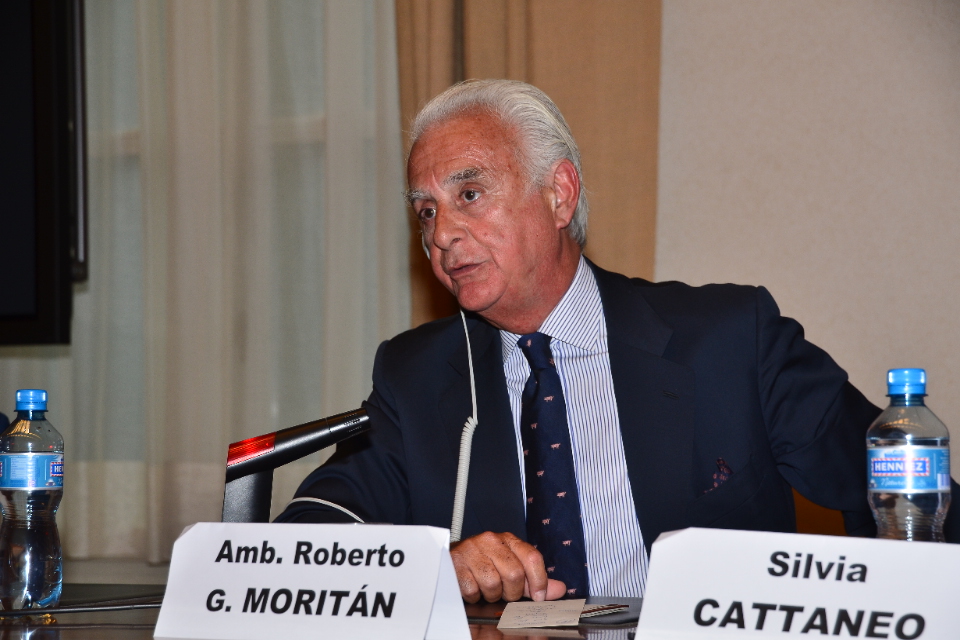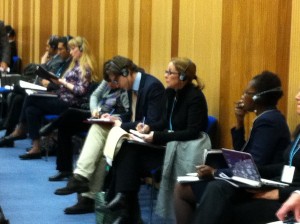Posts Tagged ‘PoA’
Taking Stock of the UN Arms Trade Treaty
Tuesday, July 9th, 2013The Arms Trade Treaty As Gateway Framework For National Small Arms Control And Disarmament
By Jeff Moran | Geneva
Image: (c) Jeff Moran
On 20 June Ambassador Roberto Moritán (Argentina), the former President of the 2012 UN ATT Conference and Chairman of the pre-negotiations process, spoke as part of a public briefing on the ATT at the United Nations in Geneva titled “The Arms Trade Treaty: Past, Present, Future.”
Amb. Moritán explained the ATT should not be seen as a static treaty, like others within the traditional arms control and disarmament field. Instead, he explained that the ATT is best understood as an ongoing process and a framework…dynamic and expandable with amendments and additional protocols perhaps. Additional protocols were understood to mean distinct treaties negotiated in addition to the ATT. An example of a disarmament treaty with additional protocols of would be the 1980 Convention on Certain Conventional Weapons.
Expanding on this theme, Amb. Moritán stated the current “scope,” “parameters,” and “criteria” within the existing treaty “need additional negotiation.” In particular, he said the scope of the treaty should be expanded over time in light of technological developments, and cited scientific achievements in robotics as one reason for this. He concluded by stating “the ATT has to lead to negotiations in conventional weapons. Negotiations of conventional weapons cannot continue to be a taboo in the United, Nations.”
If the ATT is to become a broader framework for ongoing negotiations on conventional arms control and disarmament, it is only a matter of time before the volume of the UN small arms control discussion turns up. This was hinted at during the follow-on presentation by Sarah Parker of the Small Arms Survey, the UN’s go-to resource for small arms control research and policy development.
Ms. Parker presented a PowerPoint version of a report she published earlier this month called: “The Arms Trade Treaty: A Step Forward in Small Arms Control?”. She explained in her report that while “the ATT has contributed several missing pieces to the framework of controls governing the international transfer of small arms,” it nonetheless has “provisions that are, in many cases, weaker than existing commitments on small arms transfers agreed more than a decade ago.” The key takeway: the ATT needs more work with respect to controlling and documenting international small arms transfers at the very least.
But normative developments within the ATT and broader small arms process framework will not likely be limited to controlling and documenting international small arms transfers. Given the history of the ATT negotiations and the small arms process, restrictions on transfers of small arms to “non-state actors” or “private actors” (diplomatic homonyms that often mean rebel groups, private corporations, or individuals) will probably reappear on the UN agenda through implementation and expansion of the ATT framework. So might global restrictions in the form of national controls on civilian access or even outright prohibitions on civilian possession of certain types of small arms.
In this direction, a coalition of UN agencies and contracted small arms control advocates have been quietly developing a series International Small Arms Control Standards (ISACS) since 2008. Some ISACs were released last year, but the project coordinator reports remaining ones are going to be released this year. Privately, diplomats and ISACS advocates confirm that these will be “of use” and that many states hope a critical mass of these standards become the basis for future negotiations to amend the ATT. Amendments to the ATT can be voted on six years after the instrument enters into force, and during meetings of States Parties only every third year thereafter. Decisions on amendments will not be made by consensus, but through a three-fourths majority vote of States Parties in the room.
Two ISACS are thought to be of particular interest to those seeking to amend the ATT. The first is ISACS number 03.20, “National Controls Over The International Transfer Of Small Arms And Light Weapons.” Among other things, 03.20 has a provision that prohibits international transfers to private actors without “end-user certification.” The second is ISACS number 03.30,“National Controls Over the Access of Civilians to Small Arms and Light Weapons.” Among other things, 03.30 requires national registration of firearms and owners, prohibitions on civilian possession of certain weapons Americans can already legally and legitimately possess with additional licensing, and even has language advocating for national home inspections of private gun collections for “safety compliance.” This second standard was written by Dr. Ed Laurance, who is a former strategic planner for IANSA. IANSA stands for the International Action Network on Small Arms, which, according to page 3 of its foundation document, is committed to “reducing the availability of weapons to civilians in all societies.” (More information on draft versions of ISACS 03.30 and 03.20 and other ISACS involving national controls can be found here.)
If the ATT negotiations to date and the 112 signatories to the 2006 Geneva Declaration are any indicator, most if not a three-quarters majority of UN member states would endorse “private actors,” “end-user certification,” and “civilian access” appearing on the UN’s small arms control and disarmament agenda with the ATT. In fact, Ms. Parker, along with her colleague Markus Wilson, even suggest in their small arms process guide for diplomats that a prohibition on transfers to private or non-state actors and prohibitions on civilian possession would have already become established, if not binding, international norms by now were it not for the singular opposition of the United States during the 2001 UN Conference on the Illicit Trade in Small Arms and Light Weapons in All Its Aspects, which resulted in the politically binding Program of Action (PoA).
Of course, the ATT can and should do much good to help establish badly needed import/export controls with respect to conventional weapons in States currently lacking them. The ATT should also and rightly compel appropriate humanitarian criteria into exporting State decision making where such criteria are missing or weak. But can anybody deny at this point that the ATT is also a giant milestone towards global small arms control and disarmament, toward “reducing the availability of weapons to civilians in all societies?” The truth is that a legally binding ATT, among other things, can and most likely will be revised and expanded to substantially achieve all that the politically-binding PoA was hoped to achieve but hasn’t, and then some.
At bottom, if the US is already the “gold standard” in terms of export controls and already applies humanitarian criteria in international weapons transfers, why again is it so imperative the US sign the ATT? Some key diplomats suggest the US signature is necessary to create a symbolic demonstration of communitarian international engagement, and that this would help encourage other key states to do the same. But if the American payment terms for signing and ratifying the ATT include a balloon payment 6 years from entry into force ultimately requiring a roll-back of American civil arms rights and privileges, perhaps the US ought not sign the treaty after all. Instead, perhaps the US and other states should focus less on international trade controls and focus more on addressing root causes of armed violence in the developing or fragile states most affected by it, namely, lack of rule of law, weak if not incompetent local governance, and corruption. Even Sarah Parker has apparently, finally, admitted in the conclusion of her aforementioned report:
“Small arms related problems have less to do with inadequate international transfer controls and more to do with controlling small arms already within their territories.”
Ms. Parker’s remark is supported by prior research making the stronger point that, in fact, for most countries around the globe, particularly for most developing or fragile states, a combination of deficient domestic regulation of legal firearms possession with theft, and loss or corrupt sale from official inventories is a more serious problem than illicit trafficking across borders.[*] Though the timing of Ms. Parker’s apparent admission (after the conclusion of the ATT negotiations) may raise certain ethical questions to some, her acknowledgement is nonetheless welcomed by this author in the spirit of it being better late than never.
Note
[*] This author first called attention to the apparent overselling of the ATT’s benefits in this regard in 2012. See http://tsmworldwide.com/dishonest-humanitarianism/ at notes 17, 18, and 19, which address research invalidating the overhyped claim by many ATT proponents, including the UN Office of Disarmament Affairs, that there was ever and still is a large problem of international trafficking of small arms. Real scholarship shows, contrary to ATT advocacy campaigning message, that the problem of international trafficking of small arms is actually quite small, and isolated to specific troubled states or sub-regions. Key source: Owen Greene and Nicholas Marsh, eds. Small Arms, Crime and Conflict: Global Governance and the Threat of Armed Violence. Routledge: 2012. P. 90-91.
About The Author
Jeff Moran lives in Geneva, Switzerland and is a consultant specializing in the ethical and responsible development of the international defense, security, and shooting sports industries at TSM Worldwide LLC. Previously Mr. Moran was a strategic marketing leader for a multi-billion dollar business unit of a public defense & aerospace company and an American military diplomat. He is currently studying weapons law within the Executive LL.M. Program of the Geneva Academy of International Humanitarian Law and Human Rights. Mr. Moran has an Executive Master in International Negotiations and Policymaking from the Graduate Institute of Geneva, an MBA from Emory University’s Goizueta Business School, and a BSFS from Georgetown University’s Walsh School of Foreign Service.
Distribution Notices
© TSM Worldwide LLC. Online republication and redistribution are authorized when this entire publication (including title, byline, images, notes, hyper-links, and distribution note) and linkable URL http://tsmworldwide.com/taking-stock-of-the-arms-trade-treaty/ are included. See other published items at http://tsmworldwide.com/category/published/
UPDATE: UN Arms Trade Treaty
Wednesday, October 24th, 2012By Philip L. Watson
Executive Director
The evolution of the United Nations Arms Trade Treaty (ATT) from the “Firearms Protocol” and the “Programme of Action on Small Arms and Light Weapons” (PoA) for more than a decade continues despite the failure to reach agreement on the ATT this last July.
On October 15-19 the “Conference of the Parties to the United Nations Convention against Transnational Organized Crime” was held in Vienna Austria. IAPCAR’s Julianne Versnel and Alan Gottlieb attended the meeting via the WFSA on behalf of the Second Amendment Foundation. In the past, the UN’s “Conference of Parties” has served as a bureaucratic and educational platform supporting the Firearms Protocol, the Programme of Action, and the ATT.
At this meeting the “illegal” trade in small arms used for sport and/or self-defense was lumped in with various forms of crime such as human trafficking, drug trafficking, terrorism, counterfeiting, and organized crime.
A resolution was passed to continue the working group’s study and recognizing the legitimacy of firearms with sporting uses.
Mexico was apparently vehement on not mentioning firearms in civilian possession. Rather, their preferred method of mentioning firearms replaces “civilian possession” with “lawful use.” This proposed verbiage would presumably give governments and the UN more authority to limit civilian use of firearms.
The Mexican delegation also hosted a side event titled “Arms Trade Treaty, Firearms Protocal and Small Arms Programme of Action: Three essential components of effective firearms control. What options for synergies?” The main stated goal of the meeting was to “establish synergies” among the UN Programme of Action on Small Arms, the Firearms Protocol, and the UN Arms Trade Treaty. During the meeting a representative from a different group advised against changing terms and contexts that had already been negotiated.
At the main meeting, a representative from Russia questioned the motives, funding sources, and accuracy of the so called “Small Arms Survey,” a yearly publication distributed by the Graduate Institute of International and Development Studies (GIIDS) and Cambridge Press. The 366 page tome supposedly focuses on “illicit trafficking of small arms;” however, the ‘survey’ frequently veers far off track highlighting domestic laws and issues unrelated to international affairs or the UN. The publication serves as a clear blueprint and source of skewed data for a political agenda against the civilian use of firearms.
In addition to the “Small Arms Survey,” GIIDS also frequently produces “Research Notes” and “Issue Briefs” for dissemination at UN meetings. These smaller, pithier handouts are distributed at meetings backing up the yearly ‘Survey’ to constantly reiterate their request for increased regulation on civilian arms.
The UN ATT is likely to resurface again. Overall, the goals of our opposition have not, and will not change. In the defense of the human right of self-defense, IAPCAR will continue to monitor these events closely.
UN’s “Outcome document” for the Programme of Action to Prevent Combat and Eradicate the Illicit Trade in Small Arms and Light Weapons in All Its Aspects
Friday, September 21st, 2012Document can be seen at: UN’s “Outcome document” for the Programme of Action to Prevent, Combat and Eradicate the Illicit Trade in Small Arms and Light Weapons in All Its Aspects
Original Document Via: United Nations Review Conference 2012 Programme of Action on small arms and light weapons


